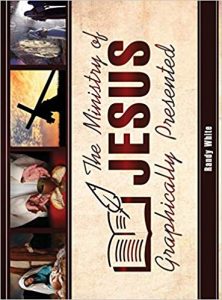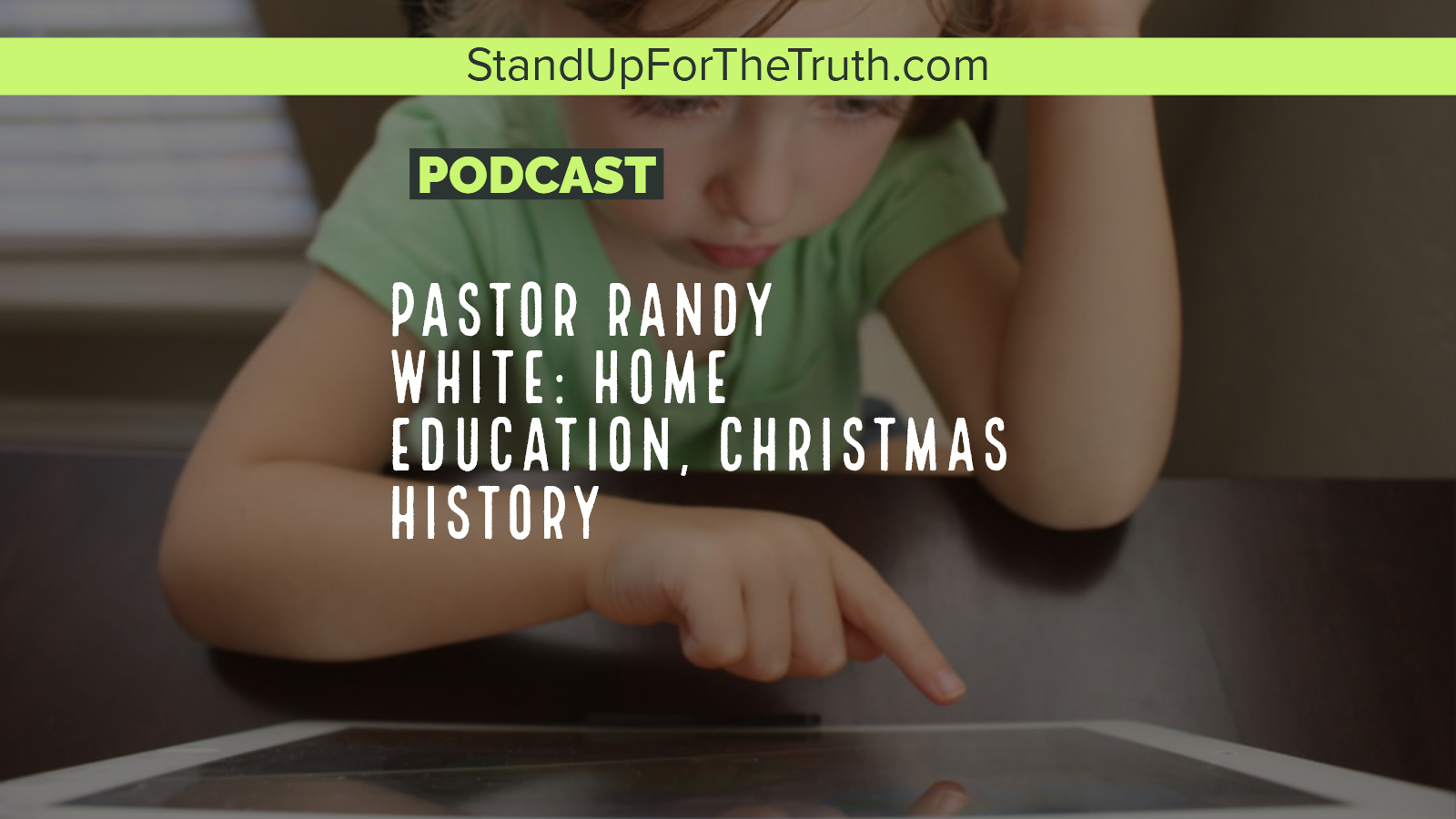 TODAY’S GUEST: Author and Pastor Randy White, founder of John Nelson Darby Academy, has been a pastor for 25 years and regularly leads tours of the Holy Land. Randy White Ministries was started in 2011 as an online and radio Bible teaching ministry, focused today on producing verse-by-verse Bible teaching resources for individuals.
TODAY’S GUEST: Author and Pastor Randy White, founder of John Nelson Darby Academy, has been a pastor for 25 years and regularly leads tours of the Holy Land. Randy White Ministries was started in 2011 as an online and radio Bible teaching ministry, focused today on producing verse-by-verse Bible teaching resources for individuals.
He is the author of several books: The Antichrist, The Three Statements of Thomas (Randy White Ministries, 2012) and The Faith of Benjamin Franklin (2013), and The Church Graphically Presented. Dr. White launched Dispensational Publishing House in 2015.
SEGMENT 1
QUESTIONS we asked Pastor Randy about home-based education and what Christian parents want to know: How does the John Nelson Darby Academy teach students? What are some of the problems of classroom style education that caused you to start the Darby Academy? Doesn’t a child miss out on social development? What kinds of classes are taught? What does a “Day in the life of a student” look like?
 SUGGESTED BOOK, “The Ministry of Jesus Graphically Presented”
SUGGESTED BOOK, “The Ministry of Jesus Graphically Presented”
The four Gospels in the New Testament present, with historical accuracy, the life and ministry of Jesus Christ. However, the interpretation of the four Gospels has been far from consistent, let alone true to the Word of God. In The Ministry of Jesus Graphically Presented, Dr. Randy White attempts to visually depict the works and words of Jesus through a series of 37 charts. These charts give the theological impact of the ministry of Jesus in an easy-to-comprehend format. Presented from a dispensational perspective, the charts give the student a means of seeing the overall scope of the Scriptures.
SEGMENT 2
WHAT WE MAY NOT KNOW ABOUT HISTORY, THE BIRTH OF JESUS (Notes from Dr. Randy White)
Mary was a seasoned traveler
• Many people have the mistaken idea that First Century Jews rarely, if ever, left their home town.
• In actuality, Mary and almost all first century devout Jews were seasoned travelers.
o Mary went to Hebron and spent three months there (presumably traveling alone) immediately after she discovered she was with child. According to Google maps, a bicycle ride (equivalent to a donkey ride) from Nazareth to Hebron is approximately 12 hours.
o Mary and Joseph went to Passover in Jerusalem every year (Luke 2:41).
Mary and Joseph went to Bethlehem because of a decree for an apographo.
• Like an autograph and apograph is “in writing.”
• The record contained census information as well as a record of a family’s assets.
• The record was used for taxation and other political purposes.
• This was not something that could be done except in person.
• The record of these decrees is abundant, though this particular decree is not recorded in history outside the Bible (Luke 2:1)
There probably was no “inn” and no “innkeeper.”
• Almost every Christmas play has the heartless innkeeper who rejects the young man and his pregnant wife. Likely such a scene never occurred.
• The misrepresentation comes from the common translation of Luke 2:7.
• The word κατάλυμα [kataluma] is the word used to describe the upper room where Jesus had the Last Supper. It is not a hotel, but the “spare bedroom” or “guestchamber” (Mark 14:14-15).
Bethlehem was a tiny town with a great history.
• At the time of Jesus’ birth, there were probably only a few hundred people living in Bethlehem.
• The city is mentioned by name 49 times in the Scriptures.
o The first mention is the burial of Rachel, wife of Jacob (Gen. 35:19)
o It is mentioned as being in the territory of Judah in Joshua 19:15.
o It was the home of Elimelech and Naomi, and later Ruth and Boaz, and finally the birthplace of King David.
o Micah 5:4 gives prophecy that the Messiah would be born here.
o In Jesus’ ministry, he is never recorded as teaching nor working miracles in Bethlehem.
The manger was a stone feeding trough.
• The common depiction of Jesus’ birth includes a wooden barn and a wooden manger. This is very unlikely. The manger in which Jesus was laid was a feeding trough for animals (Luke 2:7).
• The Holy Land is filled with ancient feeding troughs, all made of stone, which is an abundant building material in Judea (unlike wood).
Shepherds keep watch over their flocks even in winter.
• The idea that Jesus wasn’t born in December because shepherds don’t keep watch over their sheep in the winter is utterly foolish.
Swaddling clothes were only used for sacrificial lambs.
• In modern English, a swaddled baby is wrapped tightly in a blanket.
• In ancient Israel, swaddling cloth were small strips of cloth used on lambs that were being raised for sacrifice in order to insure perfectly straight legs.
• Since no baby in ancient Israel would be wrapped in swaddling cloth, this was a perfect sign for the shepherds (Luke 2:12).
Herod the King was in a maniacal stage at the time of Jesus’ birth.
• In his last days, Herod was a crazed lunatic, and desperately fearful of anyone who might take his throne or his legacy.
• The man was wickedly egocentric from the beginning.
o There was a saying, “It is better to be Herod’s pig than his son” because he wouldn’t slaughter a pig but killed three of his sons.
o Herod had his most beloved wife, Miriame, killed and preserved in liquid so that no other man would ever have her.
• His dying wish and plan was to kill upwards of 10,000 of the leading men of Israel upon his death, all to make sure the nation mourned when he died.
Jesus was not an illegal alien in Egypt.
• Russell Moore spoke these words which are so typical of left-leaning evangelicalism: “our Lord Jesus himself was a so-called “illegal immigrant.” Fleeing, like many of those in our country right now, a brutal political situation, our Lord’s parents sojourned with him in Egypt (Matt. 2:13-23). Jesus, who lived out his life for us, spent his childhood years in a foreign land away from his relatives among people speaking a different language with strange customs.”
• The problem is that these words are not true. Jesus never left the Roman Empire (Egypt was a Roman province).
• It would have been closer to go to Egypt than to return to Nazareth.
• Egypt was filled with Jews at the time of Jesus. After the destruction of Jerusalem in 70AD, Alexandria, Egypt became the largest Jewish city in the world.
When Jesus was returned from Egypt, he went first to Judea.
• The traditional timing of several years in Egypt causes a conflict with Scripture.
• Matthew 20:21-22, when read carefully, tells us that Jesus entered Israel, was afraid, and departed. Note that he was afraid to go thither does not have to mean “not being there, he was afraid to enter.” In fact, the word is translated depart in Matthew 8:18, 14:16, Mark 5:17, and Luke 8:37. Thus, “having heard that Archelaus did reign, he was afraid to go anywhere there, but in a dream was instructed to withdraw into Galilee.”
• Luke does not mention the Egypt experience, but does mention that she went to the temple after her days of purification (Lk. 2:22, 40 days after the birth, according to Lev. 12:2-6). Luke tells us that after this experience in the Temple they returned into Galilee (Lk 2:39).
• From this we can imply that the Egypt experience must have been a short period of time between day 8 and day 40 of Jesus’ life. Thus a maximum of about a month could have been spent in Egypt.
A timeline:
o Dec. 25 – Birth of Jesus – Day zero
o January 2 – Presentation at Temple for Circumcision – Day 8
o January 6 – Arrival of the Magi – Day 12
o January 7 – Flight to Egypt – Day 13
o Late January – Death of Herod, followed by a funeral and the reign of Archelaus (this date is based upon an eclipse mentioned by Josephus).
o February 3 – Presentation of Mary at the Temple for purification – Day 40
Mary knew.
• Of the Kingdom – Lk 1:32-33
• Of the virgin birth – Lk 1:34-35
• Of the pain he (and she) would experience – Lk 2:34-35
WHAT DID THEY KNOW THAT FIRST CHRISTMAS? – sermon by Pastor Randy White


